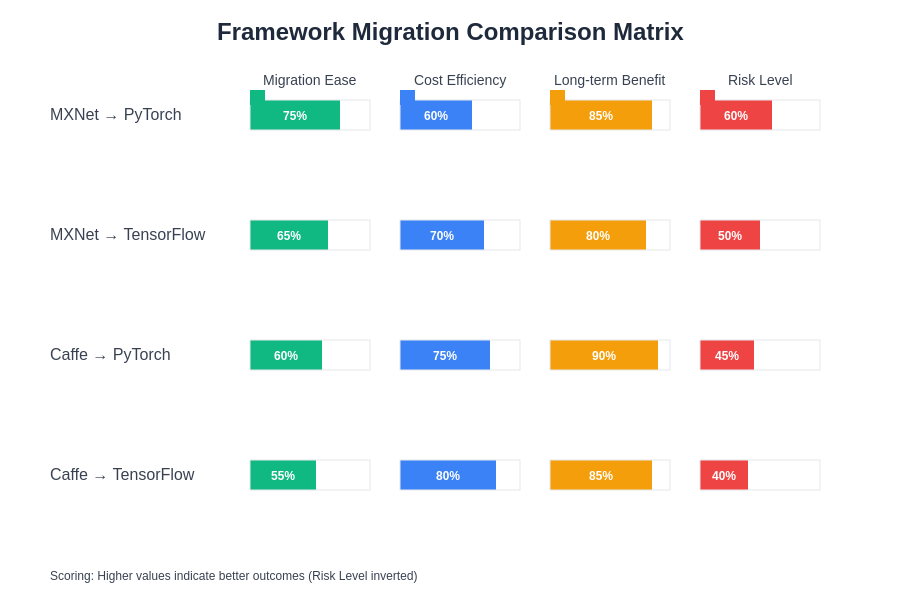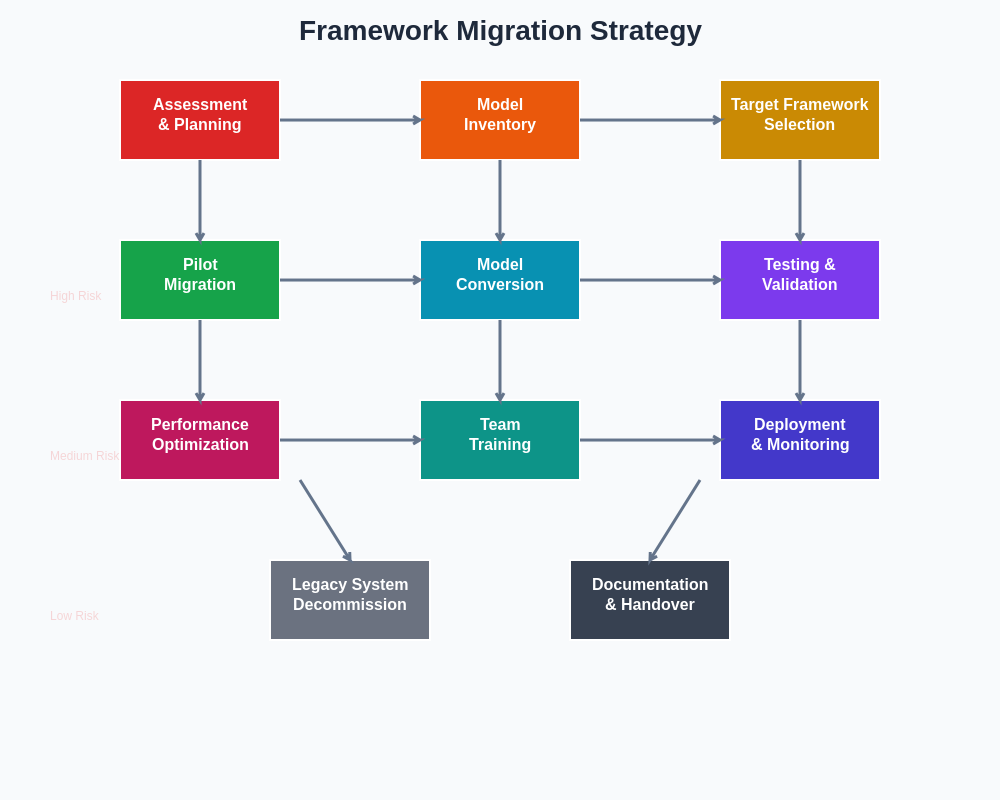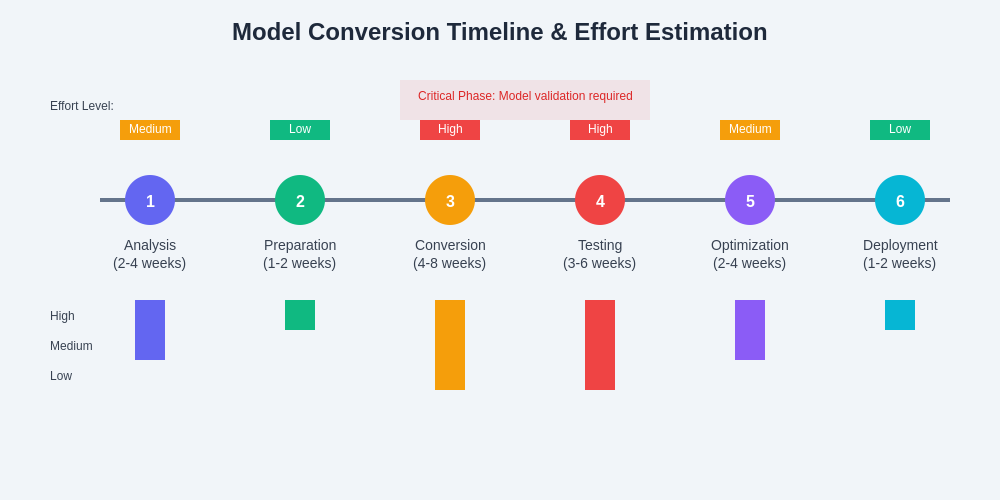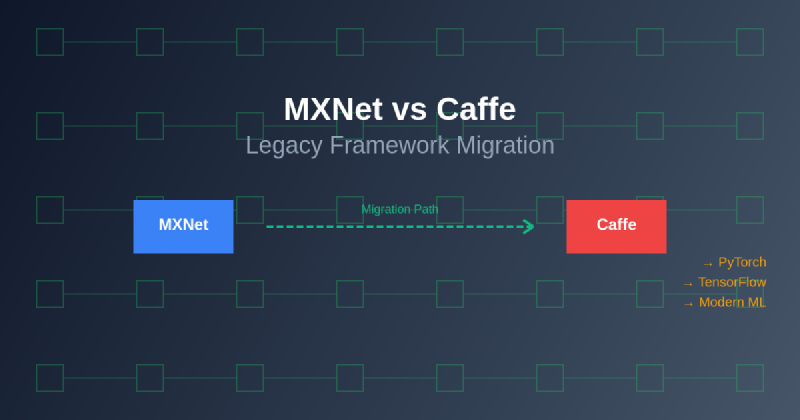The evolution of deep learning frameworks has accelerated dramatically over the past decade, leaving organizations with substantial investments in legacy systems facing critical decisions about modernization and migration strategies. Among the frameworks requiring careful consideration for migration are Apache MXNet and Berkeley’s Caffe, both of which served as foundational technologies for countless machine learning applications but now find themselves overshadowed by more modern alternatives like PyTorch and TensorFlow. The challenge of migrating from these legacy frameworks extends far beyond simple code translation, encompassing considerations of model architecture compatibility, performance optimization, team training, and long-term strategic alignment with evolving machine learning ecosystems.
Stay updated with the latest AI framework developments to understand emerging trends and make informed decisions about framework migrations that align with industry best practices. The complexity of framework migration demands thorough understanding of both technical requirements and strategic implications, making it essential for organizations to approach these transitions with comprehensive planning and expert guidance.
Understanding the Legacy Framework Landscape
The emergence of MXNet and Caffe represented significant milestones in the democratization of deep learning capabilities, each bringing unique strengths and architectural philosophies that shaped the early development of production machine learning systems. Apache MXNet distinguished itself through its flexible programming model that supported both symbolic and imperative programming paradigms, making it particularly attractive for researchers who needed the flexibility to experiment with novel architectures while maintaining the efficiency required for production deployments. The framework’s support for multiple programming languages, including Python, Scala, R, and Julia, positioned it as a versatile solution for organizations with diverse technical teams and varying expertise levels.
Berkeley’s Caffe, on the other hand, pioneered the configuration-based approach to deep learning model definition, introducing the concept of prototxt files that allowed researchers to define complex neural network architectures through declarative specifications rather than imperative code. This approach proved particularly valuable for computer vision applications, where Caffe’s optimized convolutional neural network implementations delivered exceptional performance for image classification, object detection, and feature extraction tasks. The framework’s emphasis on speed and memory efficiency made it a preferred choice for deployment scenarios where computational resources were constrained or where real-time inference performance was critical.
However, the rapid evolution of the deep learning landscape has fundamentally altered the competitive dynamics among frameworks, with PyTorch and TensorFlow emerging as dominant platforms that offer superior developer experience, broader community support, and more comprehensive ecosystems of tools and libraries. This shift has created significant challenges for organizations that built substantial machine learning infrastructure around MXNet or Caffe, as continued reliance on these frameworks increasingly limits access to cutting-edge research developments, community-contributed models, and integration opportunities with modern machine learning operations platforms.
Strategic Considerations for Framework Migration
The decision to migrate from legacy frameworks like MXNet or Caffe requires careful evaluation of multiple factors that extend beyond immediate technical considerations to encompass long-term strategic implications for organizational machine learning capabilities. Organizations must assess their current model portfolio, understanding not only the complexity and performance characteristics of existing models but also their criticality to business operations and the resources required to maintain them in their current form versus the investment needed for migration.
Performance benchmarking represents a crucial component of migration planning, as organizations must ensure that migrated models maintain or improve upon their current inference speed, memory utilization, and accuracy metrics. This evaluation process often reveals opportunities for optimization that were not previously apparent, as modern frameworks typically offer more sophisticated optimization techniques, better hardware acceleration support, and improved memory management capabilities that can deliver substantial performance improvements over legacy implementations.
Experience advanced AI development with Claude to streamline your migration planning process through intelligent analysis of existing codebases and automated generation of migration strategies tailored to specific organizational requirements. The complexity of framework migration benefits significantly from AI-assisted analysis that can identify potential compatibility issues, suggest optimal migration paths, and generate detailed implementation roadmaps.
Team readiness and skill development constitute another critical dimension of successful framework migration, as the transition often requires significant investment in training and knowledge transfer to ensure that development teams can effectively leverage the capabilities of new frameworks. Organizations must evaluate their current team’s expertise, identify skill gaps, and develop comprehensive training programs that enable smooth transitions while maintaining productivity during the migration process.
The ecosystem considerations surrounding framework choice have become increasingly important as machine learning operations mature and organizations seek to integrate their models with broader DevOps and MLOps platforms. Modern frameworks offer superior integration capabilities with cloud services, monitoring platforms, and automated deployment systems, making them more suitable for organizations pursuing comprehensive machine learning lifecycle management.
Technical Migration Strategies and Approaches
The technical implementation of framework migration requires systematic approaches that minimize risk while ensuring functional equivalence between legacy and modernized systems. Model architecture translation represents the most complex aspect of migration, as different frameworks implement neural network operations with varying semantics, numerical precision, and optimization characteristics that can affect model behavior in subtle but significant ways.
Direct model conversion tools and utilities have emerged to facilitate certain migration paths, with varying degrees of success depending on the complexity of the models being converted and the similarity between source and target framework architectures. For MXNet models, conversion to PyTorch or TensorFlow often involves translating symbolic computation graphs into equivalent representations in the target framework, a process that requires careful attention to operator semantics, tensor shapes, and numerical precision to ensure that converted models produce identical outputs to their original implementations.
Caffe model migration presents different challenges, as the framework’s prototxt-based architecture definitions must be translated into the imperative or graph-based representations used by modern frameworks. This process often requires manual intervention to handle custom layers, specialized operators, or framework-specific optimizations that do not have direct equivalents in target frameworks. Organizations frequently discover that seemingly straightforward migrations require substantial rework of model architectures to take advantage of modern framework capabilities while maintaining compatibility with existing training data and inference pipelines.
The iterative approach to migration has proven most effective for complex model portfolios, allowing organizations to migrate models incrementally while maintaining parallel operation of legacy and modernized systems during transition periods. This approach enables thorough validation of migrated models, gradual team training on new frameworks, and risk mitigation through phased rollouts that can be reversed if issues are discovered during the migration process.
Model Conversion and Compatibility Challenges
The process of converting models between frameworks involves numerous technical challenges that require deep understanding of both source and target framework architectures, as well as careful attention to numerical precision and computational semantics. Weight and parameter conversion represents the most straightforward aspect of model migration, as neural network parameters are typically stored as numerical arrays that can be transferred between frameworks with appropriate handling of tensor shapes and data layouts.
However, the complexity increases significantly when dealing with custom layers, specialized operators, or framework-specific optimizations that do not have direct equivalents in target frameworks. Organizations often discover that models utilizing advanced features of legacy frameworks require substantial architectural modifications to achieve equivalent functionality in modern frameworks, potentially affecting model performance and requiring retraining or fine-tuning to restore original accuracy levels.

The comparative analysis of different migration paths reveals significant variations in complexity, cost, and expected benefits across various framework combinations. Understanding these trade-offs enables organizations to select migration strategies that align with their technical capabilities, resource constraints, and strategic objectives while maximizing the likelihood of successful outcomes.
Numerical precision considerations become particularly important during model conversion, as different frameworks may implement floating-point arithmetic with varying precision characteristics that can accumulate into significant differences in model outputs. This issue is especially problematic for models that have been quantized or optimized for specific hardware platforms, as these optimizations may not transfer directly to new frameworks and may require complete reimplementation using target framework optimization techniques.
Leverage Perplexity’s research capabilities to stay informed about the latest model conversion tools and techniques that can streamline your migration process and reduce the risk of compatibility issues. The rapidly evolving landscape of framework interoperability tools requires continuous monitoring to identify new solutions that can simplify complex migration scenarios.
Performance Optimization During Migration
Framework migration presents unique opportunities for performance optimization that extend beyond simple functional equivalence to encompass improvements in inference speed, memory utilization, and hardware acceleration capabilities. Modern frameworks typically offer more sophisticated optimization techniques than their legacy counterparts, including advanced graph optimization, automatic mixed precision training, and improved support for specialized hardware accelerators like GPUs and TPUs.
The migration process often reveals opportunities for architectural improvements that were not apparent or feasible within the constraints of legacy frameworks. Organizations frequently discover that models originally designed around the limitations of older frameworks can be substantially improved through architectural modifications that take advantage of modern framework capabilities, such as dynamic computation graphs, more efficient attention mechanisms, or advanced normalization techniques.
Memory optimization represents a critical consideration during migration, as modern frameworks often provide better memory management capabilities that can reduce the memory footprint of deployed models while improving inference throughput. This is particularly important for organizations operating in resource-constrained environments or seeking to reduce the operational costs associated with model deployment and inference.
Hardware acceleration capabilities have evolved significantly since the development of legacy frameworks, and migration provides opportunities to take advantage of modern GPU architectures, specialized AI processors, and cloud-based inference services that may not have been available or well-supported by original framework implementations. Organizations often find that migrated models can achieve substantial performance improvements through better utilization of modern hardware capabilities.
Risk Management and Validation Strategies
Successful framework migration requires comprehensive risk management strategies that ensure functional equivalence between legacy and modernized systems while minimizing the potential for service disruption or model performance degradation. Validation protocols must be established to verify that migrated models produce identical or acceptably similar outputs to their original implementations across diverse input scenarios and edge cases.
The establishment of comprehensive test suites represents a critical component of migration validation, encompassing not only functional correctness but also performance characteristics, resource utilization, and integration compatibility with existing systems. Organizations must develop testing frameworks that can compare model outputs across different frameworks while accounting for acceptable variations due to numerical precision differences or optimization variations.
Rollback strategies and contingency planning become essential elements of migration risk management, as organizations must be prepared to revert to legacy systems if critical issues are discovered during the migration process or after deployment of modernized models. This requires maintaining parallel infrastructure capabilities and comprehensive documentation of migration steps to ensure that reversions can be executed quickly and reliably.
Monitoring and observability capabilities must be enhanced during migration to provide detailed visibility into model performance, resource utilization, and output quality across both legacy and modernized systems. This monitoring infrastructure enables early detection of issues and provides the data necessary for informed decision-making about migration progress and system reliability.
Organizational Change Management
Framework migration extends beyond technical implementation to encompass significant organizational change management challenges that require careful attention to team dynamics, skill development, and process evolution. Development teams must be prepared for substantial changes in their daily workflows, debugging approaches, and optimization techniques as they transition from familiar legacy frameworks to new technologies with different paradigms and capabilities.
Training and skill development programs must be designed to bridge the gap between legacy framework expertise and modern framework capabilities, ensuring that team members can effectively leverage new tools and techniques while maintaining productivity during the transition period. This often requires investment in external training resources, internal knowledge sharing programs, and dedicated time for experimentation and learning.
Process and workflow adaptation represents another critical dimension of organizational change, as migration often reveals opportunities to improve development practices, model lifecycle management, and deployment procedures. Organizations frequently discover that modern frameworks enable more efficient development workflows, better collaboration tools, and improved integration with broader software development practices.
Future-Proofing and Strategic Alignment
The selection of target frameworks for migration must consider not only current capabilities but also long-term strategic alignment with industry trends, community development momentum, and organizational machine learning objectives. Framework choice increasingly affects an organization’s ability to recruit talent, integrate with external services, and access cutting-edge research developments.
Community ecosystem considerations have become increasingly important as machine learning development becomes more collaborative and dependent on shared resources like pre-trained models, specialized libraries, and integration tools. Organizations must evaluate the long-term viability and growth prospects of potential target frameworks to ensure that migration investments will continue to provide value as the technology landscape evolves.
The emergence of framework-agnostic standards and interoperability initiatives suggests that future migrations may become less disruptive as the industry converges on common interfaces and model representation formats. Organizations should consider these developments when planning migration strategies and selecting target frameworks to minimize the risk of future migration requirements.

The comprehensive migration strategy encompasses multiple phases that must be executed systematically to ensure successful framework transitions. Each phase builds upon previous accomplishments while establishing foundations for subsequent activities, creating a structured approach that minimizes risk while maximizing the likelihood of successful migration outcomes.
Implementation Roadmap and Best Practices
Successful framework migration requires detailed implementation roadmaps that break down complex migration projects into manageable phases while maintaining system reliability and team productivity throughout the transition process. The phased approach to migration has proven most effective, allowing organizations to migrate models incrementally while validating each phase before proceeding to more complex or critical components.
Priority-based migration strategies enable organizations to focus initial efforts on models that offer the greatest potential for improvement or represent the highest risk if left unmigrated. This approach allows teams to develop migration expertise on less critical models before tackling mission-critical systems that require the highest levels of reliability and performance.
Documentation and knowledge management become critical components of successful migration projects, as teams must capture migration procedures, lessons learned, and framework-specific knowledge to enable efficient scaling of migration efforts across larger model portfolios. Comprehensive documentation also facilitates maintenance and future development of migrated systems.

The typical model conversion timeline spans multiple months and requires careful coordination of resources across different phases of the migration process. Understanding the relative effort and risk associated with each phase enables better resource planning and helps organizations establish realistic expectations for migration project timelines and deliverables.
Economic and Resource Considerations
Framework migration represents a significant investment in both time and resources that must be carefully evaluated against the expected benefits and long-term strategic value. Organizations must consider not only the direct costs of migration implementation but also the opportunity costs of diverting development resources from new feature development and the potential risks associated with system disruption during migration.
The economic benefits of migration often extend beyond immediate technical improvements to encompass reduced maintenance costs, improved developer productivity, and enhanced ability to leverage modern machine learning tools and services. However, these benefits may not be immediately apparent and require careful measurement and tracking to demonstrate return on investment.
Resource planning for migration projects must account for the learning curve associated with new frameworks, potential performance optimization requirements, and the need for comprehensive testing and validation procedures. Organizations often underestimate the time required for thorough migration validation and the resources needed to maintain parallel systems during transition periods.
The long-term economic implications of framework choice include considerations of vendor lock-in, community support sustainability, and the availability of specialized talent in the job market. Organizations must balance the immediate costs of migration against the long-term risks of continued dependence on legacy frameworks that may become increasingly difficult to maintain and extend.
Framework migration from legacy systems like MXNet and Caffe represents a complex but necessary evolution for organizations seeking to maintain competitive advantages in the rapidly advancing field of machine learning. The successful execution of these migrations requires comprehensive planning that encompasses technical, organizational, and strategic considerations while maintaining focus on long-term sustainability and alignment with industry best practices. Organizations that approach framework migration with thorough preparation, realistic timelines, and comprehensive risk management strategies position themselves to leverage the full potential of modern machine learning frameworks while building foundations for continued innovation and growth.
Disclaimer
This article is for informational purposes only and does not constitute professional technical advice. Framework migration decisions should be based on thorough evaluation of specific organizational requirements, existing system architectures, and long-term strategic objectives. The migration strategies and techniques discussed may not be suitable for all scenarios, and readers should consult with qualified technical professionals before implementing significant changes to production machine learning systems. The effectiveness of migration approaches may vary depending on model complexity, organizational resources, and specific technical requirements.
